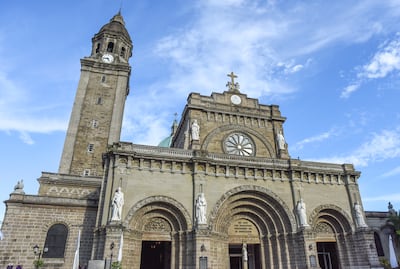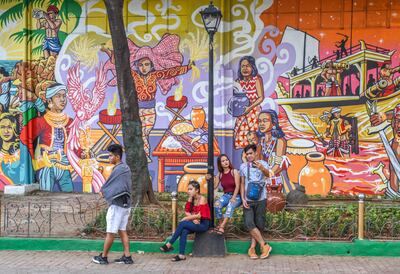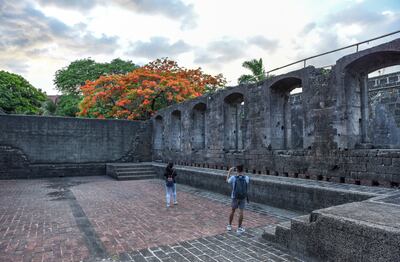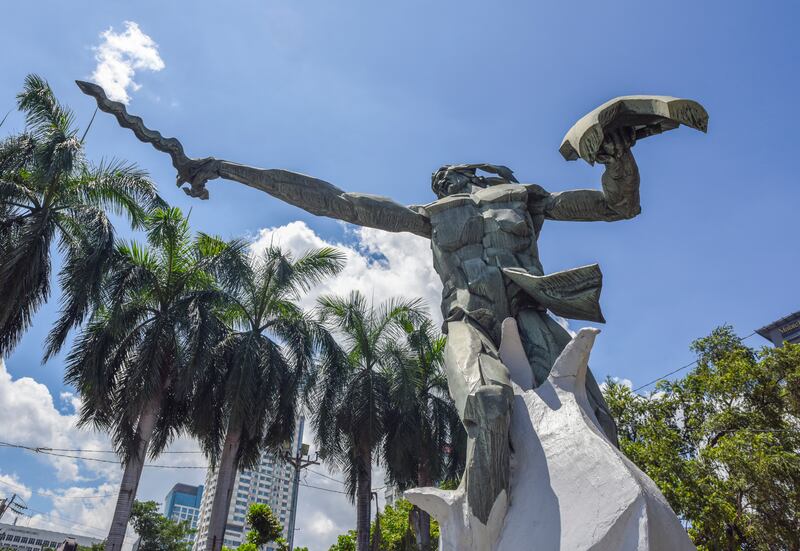In the historic heart of Manila, high, weathered walls surround the city’s most unique tourist attraction, Intramuros. These fortifications were erected nearly 450 years ago, and have since protected the stately churches, museums and mansions of this citadel, which was built by the Spanish after they invaded the Philippines.
Near the eastern edge of this beautiful and fascinating fortress, I wandered into ruins with a title that intrigued me — the Rajah Sulayman theatre. Neither Spanish nor typically Filipino, this name seemed out of place. Yet it also felt familiar, as if I had come across Rajah Sulayman previously during this trip to Manila.

As it turns out I had, twice already that day. Sulayman is a 16th century Muslim hero in this majority-Christian nation. Our first encounter was in a small, neat green space alongside Manila Baywalk, the long, attractive boulevard that hugs Manila Bay and is frequented by ornate horse-drawn carriages that offer pleasure rides to tourists.
I had headed to this neighbourhood of Malate ― popular with foreign travellers ― to see the magnificent, 400-year-old Baroque Malate church, one of the city’s many, splendid and ancient Catholic buildings. Opposite that popular attraction was a large, metal statue of a warrior wielding a shield in one hand and a sword in the other. This was my initial glimpse of Sulayman, who stood proudly in the park named in his honour.
He was less of a focal point in nearby Rizal Park, where I next found him. That enormous green lung, which with its wide lawns, many monuments and adjoining museums is one of the city’s finest attractions, is instead dedicated to a different leader who fought the Spanish. That man is Dr Jose Rizal, who was executed here and became a martyr who inspired the Philippines to regain its freedom after three centuries of Spanish rule.
Wandering Rizal Park, alongside its snack vendors, canoodling couples and picnicking families, is one of Manila’s unmissable tourist experiences. It also took me past more than a dozen large busts of Filipino historical figures, including Sulayman.

By the time I encountered Sulayman's image for the third time, in that crumbled Intramuros theatre, I wanted to know who he was. A search online unravelled a thread of Filipino history with which I was unfamiliar, but tourists can learn about by visiting Manila’s sprawling National Museum complex adjacent to Rizal Park.
There they’ll read that Sulayman was one of many Filipino Islamic leaders who challenged the Spanish when they attempted to conquer every part of this nation, starting from the 1520s. I use the word attempted because they were not successful. This was due in part to the courageous counterattacks of those Muslim warriors, including Sulayman.
That museum complex explains that the Philippines is home to more than six million Muslims, about 6 per cent of its population. The majority live in Mindanao, the Philippines’ second-largest island. It was there, in the country’s deep south, that the Philippines’ first Islamic state was born in the early 1400s. That was called the Sulu Sultanate, and then in the 1520s another sultanate, Maguindanao, was established in the deep south.

Soon, both those Islamic territories would have to deal with a new threat. In 1565, the Spanish created their first permanent settlement in the Philippines, marking the start of 333 years of colonial occupation. While those Europeans had little trouble conquering some parts of this nation, they encountered stern resistance from its Islamic territories.
Both the Sulu and Maguindanao sultanates survived the Spanish era, while in Manila these invaders were given a fierce fight by that man I kept meeting, Rajah Sulayman. When tourists now stroll the historic streets of Intramuros, they’re exploring what in the 1500s was a Muslim kingdom called Maynila. A vassal state of the powerful Islamic sultanate of Brunei, Maynila was ruled by Sulayman and Rajah Matanda when the Spanish arrived there in 1570 seeking a location for their new capital.
Visitors to Intramuros can stand atop its northern walls and look west down the adjacent Pasig River, to its mouth at Manila Bay, where Spanish boats appeared all those years ago. What happened thereafter varies significantly depending on the historical account you read.
Some historians suggest Sulayman allowed the Spaniards to settle in Maynila, in exchange for royalties. Others claim he overruled such an offer made by fellow leader Matanda and then violently expelled the Spanish from Maynila. The plaque beneath his statue in Rizal Park calls him a “brave Muslim ruler” who “refused the offer of friendship by the Spaniards, which actually would have meant the loss of the freedom of his people”.
Maynila was badly damaged during that battle with the Spanish in 1570, but when this colonial force invaded once more the next year, Sulayman again would not budge. This time, however, fate favoured the Spanish. More experienced in warfare, their fleet swept into Maynila and overwhelmed Sulayman’s troops. He died in 1571 fighting alongside his men.
Sulayman’s refusal to cede or flee in the face of colonial aggression earned this Muslim warrior many admirers. Even now, 450 years later, his courage is fondly remembered in Manila. That is why, when you next visit this city, you’re likely to encounter the name Rajah Sulayman.






